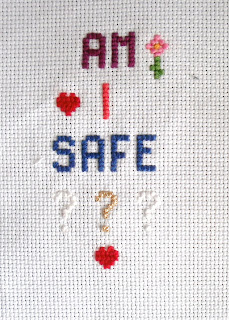Performance art is weird isn’t it? It straddles the gap between mime, acting and unfortunately, on occasions, straightforward annoyance. But I was truly eager to try it, perhaps more than anything else on my ever lengthening art-to-do list, which is why on one glorious sunny day, I was seen wearing (please no – not a bunny costume!) a bunny costume while wandering around a park.
Whenever I witness performance in a gallery, I am never sure exactly how to react: do you applaud, or ignore it? Maybe critique it as you would a painting, or stand and gaze in awe? It’s so very difficult.
I’ve seen a few performances recently: one involved a breathless woman skipping around whilst reciting snatched phrases from a script. Most people sat still and scratched their chins (when not glaring at me, the philistine who forgot to turn off her mobile phone. Really sorry about that.)
Another was unexpected and sinister: two cloaked figures brandished small ornamental pyramids and enacted an elaborate ritual, to rapturous applause when - eventually - it ended.
And I’m still wondering: when performance occurs outside gallery confines, where does it exist? Is it real only when others can see it in the form of a film and/or photograph, or do you have to be there? I plan to use the subsequent photographs for some more photomontages, but seriously, to enjoy the performance itself, you really had to experience it yourself.
My make-shift costume was resonant of, but did not replicate, a bunny. I met a friend/collaborator in a park, who managed to attach the home-made rabbit ears. I couldn’t see a thing when wearing the eye-patches painted over with tippex, which was the point of it all. I walked aimlessly around, pausing to pose for photos (and messed the image up slightly by having a bulging carrier and handbag in full shot.)
The totem/metaphor for my time spent blind has become a giant bunny rabbit (it looked like a bunny – it was actually a man waving his arms around.) That bunny has been appearing in my paintings, but the vision of a huge rabbit must have come from my own unconscious memory. It is part of me, so I absorbed and became it.
I didn’t bother with the full-on furry bunny costume I toyed with previously (most notably for graduation day at the art-school I decline to name, an omission I now deeply regret.) For the performance, it would have too much, more so than bunny ears. As I wandered around amongst some lush foliage pausing next to street lamps apparently straight out of Narnia (how appropriate) everything made sense. I couldn’t imagine painting or sewing about this one moment in my life, that is, showing others what I had seen, namely a giant bunny.
Onlookers remained aloof, although I had been willing to engage with them. People were curious, but this event occurred next to an art gallery, so perhaps rabbit-related performance art is commonplace. Please note: I am available for formal functions. See my agent – the guy with long ears and big teeth.









